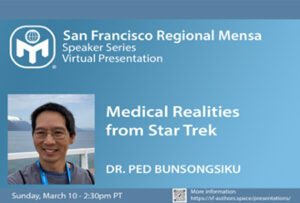
The first Star Trek episode aired on September 8, 1966. The TV show, set in the far future, imagined technology far beyond anything of that time.
We still don’t have warp drives or transporters. Amazingly in some areas the technology of Star Trek is now real. It was a sight gag when Scotty tried to talk to a computer. Virtual Reality is very similar to the Enterprises holodeck.
In the area of medicine Star Trek introduced several advanced technologies. Dr. Ped Bunsongsikul will discuss medical predictions that are realities today.
Dr. Ped Bunsongsikul has been a Kaiser Permanente Family physician for over 20 years. He is board certified in family medicine, geriatrics, and clinical informatics. He has a bachelor’s in biomedical engineering and a master’s in health informatics. He enjoys computer programming, traveling, and solving puzzles.
Please register early.
Zoom will email the link to join this meeting:
https://livepresentation.link/SignUp
Contact: Judy Unger, junger2040@gmail.com
*****
Star Trek ‘s universe is filled with possibilities. It allowed viewers to dream of an adventure beyond the constraints of their everyday lives. The series sparked a sense of wonder and curiosity, inspiring countless individuals to explore the realms of science and fiction. Even decades after its original airing, Star Trek continues to foster a sense of wonder and encourage people to dare to dream. One of the most remarkable aspects of Star Trek is its ability to predict technological advancements that were yet to come:
- The “universal translator,” foreshadowed the development of modern translation technology.
- The “holodeck,” gave a glimpse into the possibilities of immersive virtual experiences, which we can now see in virtual reality headsets.
- The handheld communicators closely resemble modern-day smartphones.